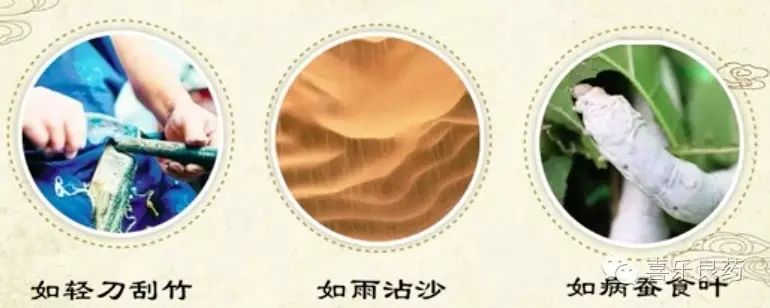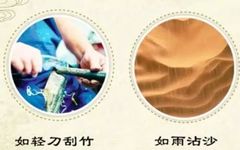Today we will learn about slippery pulse and choppy pulse.
Pulse Characteristics
Slippery Pulse: Smooth and flowing, feels round and smooth, like beads rolling.
Choppy Pulse: Thin and slow, feels difficult and obstructed, like a light knife scraping bamboo.
Specifically
The characteristic of a slippery pulse is that the shape of the pulse felt under the fingers is like three round beads rolling smoothly from the wrist to the fingers. Therefore, it can be understood as a very smooth pulse.
Slippery pulse—flows forward, smooth and turning, feels like beads, slippery as if wanting to escape.
—From the Binhu Pulse Theory
The characteristic of a choppy pulse is that the pulse shape is relatively thin and narrow, and the sensation of the pulse is one of sluggishness and obstruction, giving an impression of being very unflowing. It may even present with irregular rhythm and uneven strength. In other words, the pulse may sometimes be fast, sometimes slow, sometimes intermittent, or the strength of the pulse may vary between strong and weak. Therefore, the ancients described it as three to five irregularities.
According to the elements that constitute the pulse pattern we discussed earlier:
The choppy pulse has three characteristics: thin, slow, and irregular rhythm. Thus, it gives the feeling of like a light knife scraping bamboo, like rain touching sand, like a sick silkworm eating leaves.
Therefore, slippery pulse and choppy pulse are a pair of pulse patterns that are opposites in terms of smoothness.

Clinical Significance
Slippery Pulse: Indicates the presence of phlegm-dampness or food stagnation, or excess heat. A slippery pulse can also be seen in healthy individuals or pregnant women.
Choppy Pulse: Only appears in pathological states, with distinctions between deficiency and excess.
For example, excess patterns reflect qi stagnation and blood stasis, while deficiency patterns often reflect damage to essence and blood deficiency.
Pulse Analysis
Slippery Pulse:
1. Physiological slippery pulse can be seen in women before menstruation and during pregnancy, representing abundant and harmonious qi and blood. In healthy individuals, a slippery pulse is smooth and full, indicating richness of nutritive and defensive qi. Thus, we can understand it as a normal pulse, often seen in young people.
Currently, many women visiting clinics like to have their pulse taken to determine if they are pregnant. Generally, we still advocate for four diagnostic methods, and when necessary, to combine with Western medical examinations. As we know, the pulse may also appear slippery before menstruation, and during the first two months of pregnancy, the slippery pulse is most pronounced. Additionally, some overweight individuals may normally present with a slippery pulse. Therefore, we cannot solely rely on a slippery pulse to determine pregnancy.
2. Phlegm-dampness, food stagnation, and excess heat are all excess evils that obstruct the interior, causing qi and blood to surge, hence the pulse is round and smooth. Moreover, due to heat, blood circulation may be accelerated, so if there is heat present, the pulse may not only be slippery but also rapid, presenting as slippery and rapid pulse.
In clinical practice, many patients with anxiety or insomnia, if caused by phlegm-heat disturbing the interior, often present with a slippery and rapid pulse.
Note: Many medications can affect the pulse pattern, causing patients to exhibit a slippery pulse.
For example, after becoming ill and receiving intravenous therapy, or using some blood-activating and stasis-resolving medications, or vasodilators, the pulse may present as slippery. Additionally, the most common situation is that drinking alcohol can also cause a patient to exhibit a slippery pulse.
Choppy Pulse:
Can indicate both deficiency and excess;
When the body has insufficient essence and blood, failing to nourish the pulse vessels, the qi and blood flow is obstructed, hence the pulse is choppy and weak.
When there is qi stagnation and blood stasis, or phlegm and food accumulation, causing qi mechanism obstruction and blood flow blockage, then the pulse is choppy and strong.
Note: In clinical practice, many blood stasis patterns may not present as choppy pulses, but rather exhibit other pulse patterns.
For example, many patients with organic heart disease may present with a choppy and weak pulse, which is related to weak heart contractions.
Modern Mechanisms
1. The formation of a slippery pulse is mainly related to peripheral vascular dilation and increased arterial compliance.
1. Under physiological conditions, the formation of a slippery pulse is also accompanied by an increase in cardiac output and a decrease in total peripheral resistance.
2. In pathological conditions, a slippery pulse often occurs with decreased cardiac output and a slight increase in total peripheral resistance.
Clinical observations have shown that during external febrile conditions, when sweating is about to occur, the proportion of slippery pulses is relatively high. Because of bronchial dilation, or in cases of pulmonary tuberculosis with hemoptysis, or renal tuberculosis, or ulcer disease, when patients have a tendency to bleed, a slippery pulse may appear before bleeding.
It has also been observed that in a patient with high fever, after the fever subsides, if the pulse remains slippery, it generally indicates a possibility of relapse within two to three days.
Therefore, a slippery pulse during severe illness may indicate the deterioration, activity, or progression of certain diseases.
2. A choppy pulse often reflects significant damage to cardiovascular function.
Mainly due to weakened myocardial contractility, decreased cardiac output, reduced blood flow, slowed blood flow velocity, decreased arterial compliance, and increased peripheral resistance, these changes are the main factors forming a choppy pulse.
Summary
Slippery pulse and choppy pulse are a pair of pulse patterns that are opposites in terms of smoothness. Under physiological conditions, a slippery pulse is more common in young individuals with abundant qi and blood, or in pregnant women; under pathological conditions, it is often seen in phlegm-dampness, food stagnation, and excess heat patterns; a choppy pulse can be seen in deficiency patterns with fluid damage and blood deficiency, as well as in excess patterns with qi stagnation and blood stasis, or phlegm and food obstruction.
Specifically, we should combine pulse strength and other accompanying symptoms for differentiation. In clinical practice, slippery pulses are relatively common, while choppy pulses are relatively rare.
Long press or scan to download the Great Traditional Chinese Medicine App

The Great Traditional Chinese Medicine App is a specially designed assistant for TCM practitioners and enthusiasts. The product data references multiple authoritative institutions and classic works, and is meticulously designed for interactive display to facilitate TCM practitioners’ use, making it an essential app for TCM professionals.

